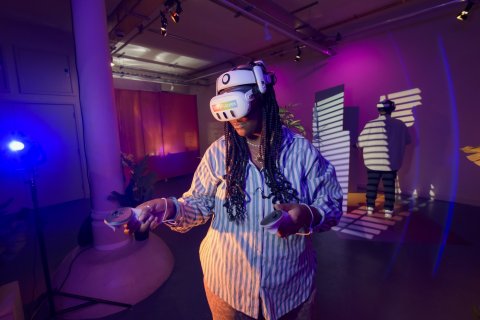Amy Rose Lead Curator, Undershed
on Thu 2 OctThe Making of Impulse: Playing with Reality
Posted on Thu 2 Oct
We asked the co-directors May Abdalla and Barry Gene Murphy a few questions about the process of making Impulse: Playing with Reality.
According to NHS England, in May 2025 it was estimated that 2,498,000 people in England have ADHD, including those without a diagnosis.
With creative flair, Impulse: Playing with Reality goes deep into the memories and lives of four people who live with ADHD – and with great sensitivity, it tells a story about how our early experiences impact on the way our lives unfold.
As with many documentaries, the piece doesn’t aim to be the definitive representation of this complex and shifting diagnostic category. It is a focused look at four people, made with compassion and curiosity, about the complex emotional landscape each one experiences.
Co-directors May Abdalla and Barry Gene Murphy share the process of making Impulse: Playing with Reality below.

Why did you make this piece?
Our past VR work, Goliath, dealt with the division between the experience of a man with a diagnosis of schizophrenia and how he was perceived by society. It unlocked a curiosity about the invisible experience in each of us and the potential of this technology to communicate it.
Soon after its release, there was a rise in public discussion about ADHD, with an undercurrent of criticism from people who were sceptical of what they considered to be fairly generic symptoms – including disorganisation, muddled thinking and strong emotions. The divisiveness was heated - whether in the classroom, the workplace or within families.
We listened to Scattered Minds by Dr Gabor Mate - and the case studies hit hard. Problem youth are often used as whipping boys for our failed societal systems and a new study was released showing that 1 in 4 prisoners in the UK had undiagnosed ADHD.
We observed that ADHD can be described by some as a person being wilfully difficult, self-involved or disrespectful. We wanted to confront the "pull up your bootlaces kind of thinking" and say "it's actually a lot more complicated than that!" - and to splice those difficult moments into their constituent parts using testimony, science, and a bit of imagination.
Ultimately, we hoped we could make something that could inspire compassion towards those individuals and help bring those two sides of the debate closer together.
How did you make this piece?
We spoke to around 75 people with lived experience of ADHD, experts, coaches, psychologists and used that as inspiration for designing interactions - such as the written text that branches into other meanings. There were key phrases like “my mind is somewhere else” or “I pay attention to everything” that ended up becoming experiential metaphors for the design.
Alongside this, we edited the testimonies into a linear story charting the lives of four individuals up until they are diagnosed. We wove that into a spatial set around the user which was storyboarded in great detail - there are over a thousand hours of work in the animations alone.
We wanted the stories to end hopefully but not fall in line with a particular narrative that celebrates ADHD as a superpower. If you’re not in the kind of social group where you get the benefit of the doubt, ADHD can be irredeemable as one impulsive act sets a whole series of troubling events in motion.
We also wanted there to be space for the audience member to see themselves in the stories - and for their own environments and presence in that real place to come into play.
Everything involved a lot of user testing to calibrate how comfortable the experience was and make it as accessible as possible for everyone.
What did you learn about ADHD through making this piece?
We found that the scale of the impact that ADHD can have on someone’s life is shocking - even when it might appear that they are managing. There is a vastness to the experience of ADHD that can lead to brilliant creativity but also torture, and for many it can be extremely lonely.
Although people are affected by ADHD in many different ways, focusing on first person stories, and listening closely to what people expressed did reveal some common threads. For everyone, there was a ‘fire’ that burned. While some tried hard to extinguish it, others watched in horror as it took over things they had wanted to protect, and some celebrated its power.
Presently in the UK, there are places with a waiting list of over 8 years for a diagnosis. For those we spoke to who had received one, it was always a threshold moment. There was a huge emotional release once their deeply personal and intangible experiences were given a name.
Even now, four years in, it feels like there’s still a lot to learn. The condition throws light on a lot of things: our expectations of ourselves and others; the impact of norms that impede an individual’s ability to succeed; and the impact we can have as a community when we look after each other.
Ultimately, we appreciated the power of individuals to support others through those challenges. This set in motion a series of impact driven projects to influence change in the workplace as well as education.
